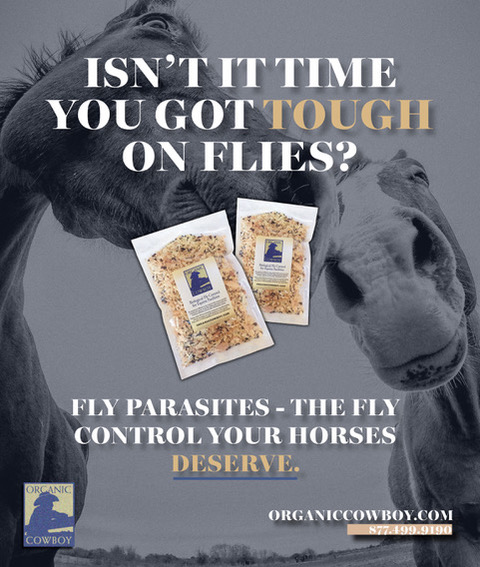
The Horse Information lives Here! ©
The #1 Horse Industry Information Advertising Directory! Contact Ann to include your company.

 Natural Fly Control by The Organic Cowboy™ The Organic Cowboy™ Our harmless gnats-sized guys prey on and kill flies, like a predator, the natural way-- no chemical sprays needed! You’re on Your Way to Season-long Fly Control
Looking for a natural, yet effective method of Fly Control? The Organic Cowboy™has the answer! Our Natural Fly parasites are a time-honored tool in the battle against pest flies, killing flies long before they become adults that spread disease and bother you and your horses. Our harmless gnats-sized guys prey on and kill flies, like a predator, the natural way. And as you remove chemicals, fly pupa-devouring beneficial predators such as Hister Beetles can thrive and enhance the overall fly control at your horse barn... best of all, you won't notice you are there, until the flies start disappearing! How Does It Work? The primary fly breeding habitats in horse stables are those areas where manure builds up along fence lines (tough to clean up areas), and where manure is stored for later removal or handling. These are the primary fly breeding habitats and this is where you’ll find fly larva in large concentrations. Step 2 – Put Your Fly Parasites to Work It’s now time to release your fly parasites and let them go to work for you. Working along the fence line, choose the areas of greater build-up, then simply peal open the top of the pack and shake out a small quan- tity of the fly parasites on to the manure. Continue with this process, until you’ve covered as much of the stable as possible. As the season progresses, you’ll begin to clearly recognize the worst fly breeding habi- tats. You should release your fly parasites there first, and then move to the secondary habitats. This is the same procedure you’ll follow with the arrival of each shipment of Organic Cowboy™Fly Parasites. Step 3 – Maintain an Effective Program Your fly parasites are now doing their job, but there are things you can do optimize your season long fly control. Along with releasing the proper number of fly parasites throughout the season, weekly stall and barn cleanup can greatly reduce the amount of fly breeding habitat and ef- fectively interrupt the fly breeding cycle. Cleanup and limited spray use in fly roosting habitats (where adult flies rest), can complement your biological fly control program. Just be sure never to apply the chemical sprays in areas where you release your fly parasites. Whether you choose to receive your fly parasites every other week or monthly, be sure to release them within 48 hours of arrival. This helps you stay ahead of the flies, and insures that the fly parasites are fresh and ready for action. If you choose to store them for a few days, keep them refrigerated, to slow their metabolism. A Little Science...
Fly parasites are a species of parasitoids from the Pteromalidae family that are endemic to North America. These species-specific parasites lay their eggs exclusively in fly pupae, which serve as their host. Our Organic Cowboy blend of fly parasites includes Spalangia cameroni, Muscidifurax zaraptor, and Muscidifurax raptorellus. This mix of multiple strains effectively controls house flies, stable flies and horn flies. Fly parasites spend their entire life cycle on or near the surface of manure and other decaying organic matter. When released near fly breeding sites, the female searches through the habitat like a predator, seeking out fly pupae. Upon locating a pupal case, she drums a hole, inserts her ovipositor, and deposits anywhere from one to a dozen eggs inside, depending on the species. She continues this process until all her eggs have been laid. The lifespan of a female fly parasite ranges from as little as two weeks to about a month. She typically lives long enough to deposit 50 to 100 eggs. The eggs laid inside the pest fly pupae develop into mature adults within 14 to 28 days, leading to a new generation of fly parasites. Contact: Matt Grainger 3845 Longwood Avenue Boulder, Colorado 80305 Phone: 877.499.9190 Email: Website: Click Here To Connect |
Have a Product or Service that would benefit Horse Owners? Contact Ann
Home, Articles, Academic Schools, Arena Maintenance, Animal Communicators, Barn and Accessories,
Barn Equipment and Tractors, Blankets Books and Videos, BReeders, Camping Gear, Career Schools, Carts and Buggies, Clinicians, Clothing, Dogs and Puppies, Horse Fencing, Fine Art & Furniture, For Sale, Fly Control, Foal Care, Footings, Gifts, Health and Nutrituon, Hoof and Leg, Horse Rehabilitation Farms, Horse Insurance, John Lyons Certified, Lawyers, Leather Care,
Links, Health , Horse Property, Photography, Portable Stalls Areanas and Roundpens, Richard Shrake, Riding Schools, Schools, Services for Horses, Shipping, Skin and Coat, Software, Specialty Trainers, Summer Camps, Tack, Trainers, Trainer Educational, Trailers, Treats and Snacks, Truck Accessories, Trucks, Vacations, Western Lifestyle
InfoHorse.com, Horse Information Lives Here ® 4/4/2025
Contact Us to Advertise to over 2 million Horse Owners.
All images and content Copyright© 2007 by InfoHorse.com, Equusite.com.